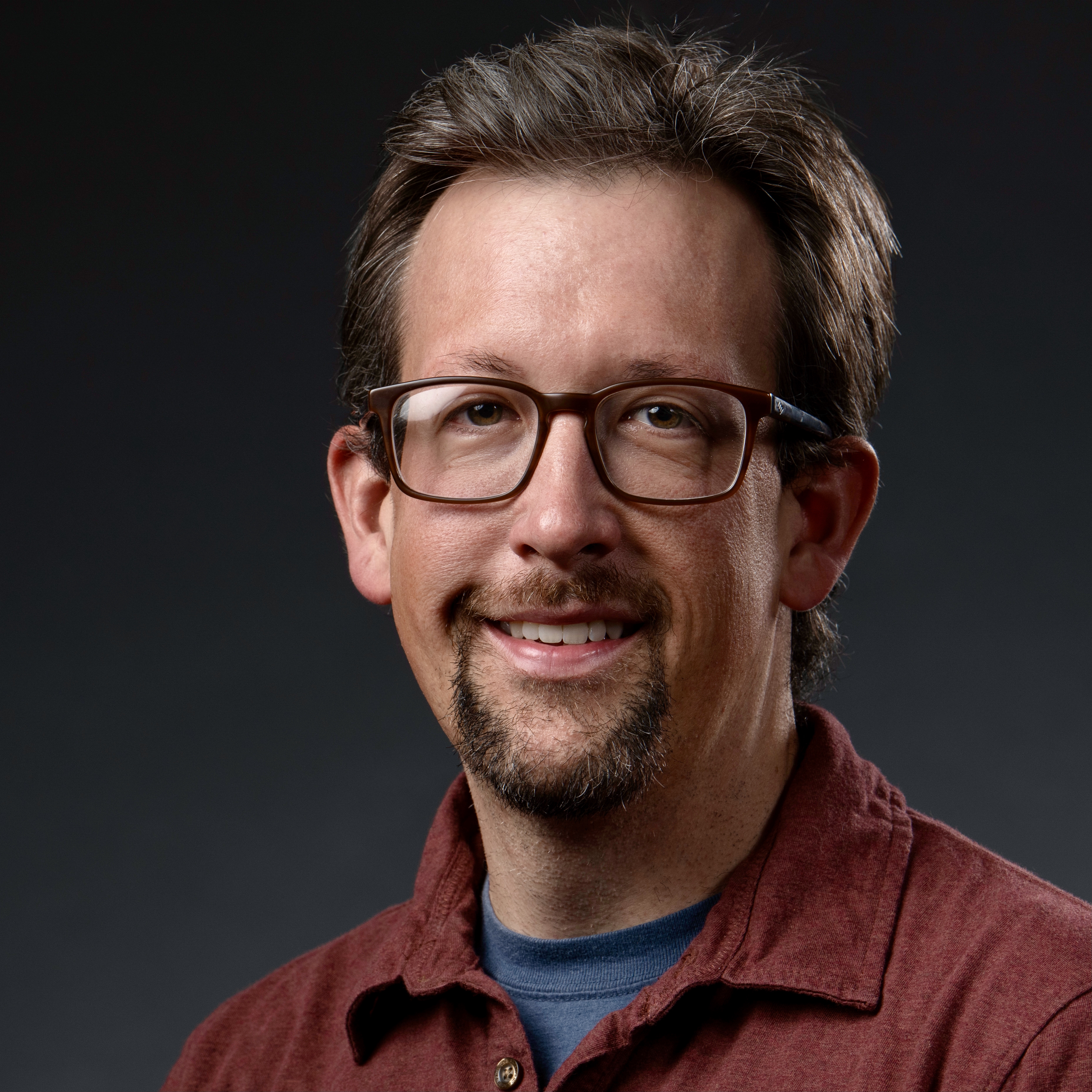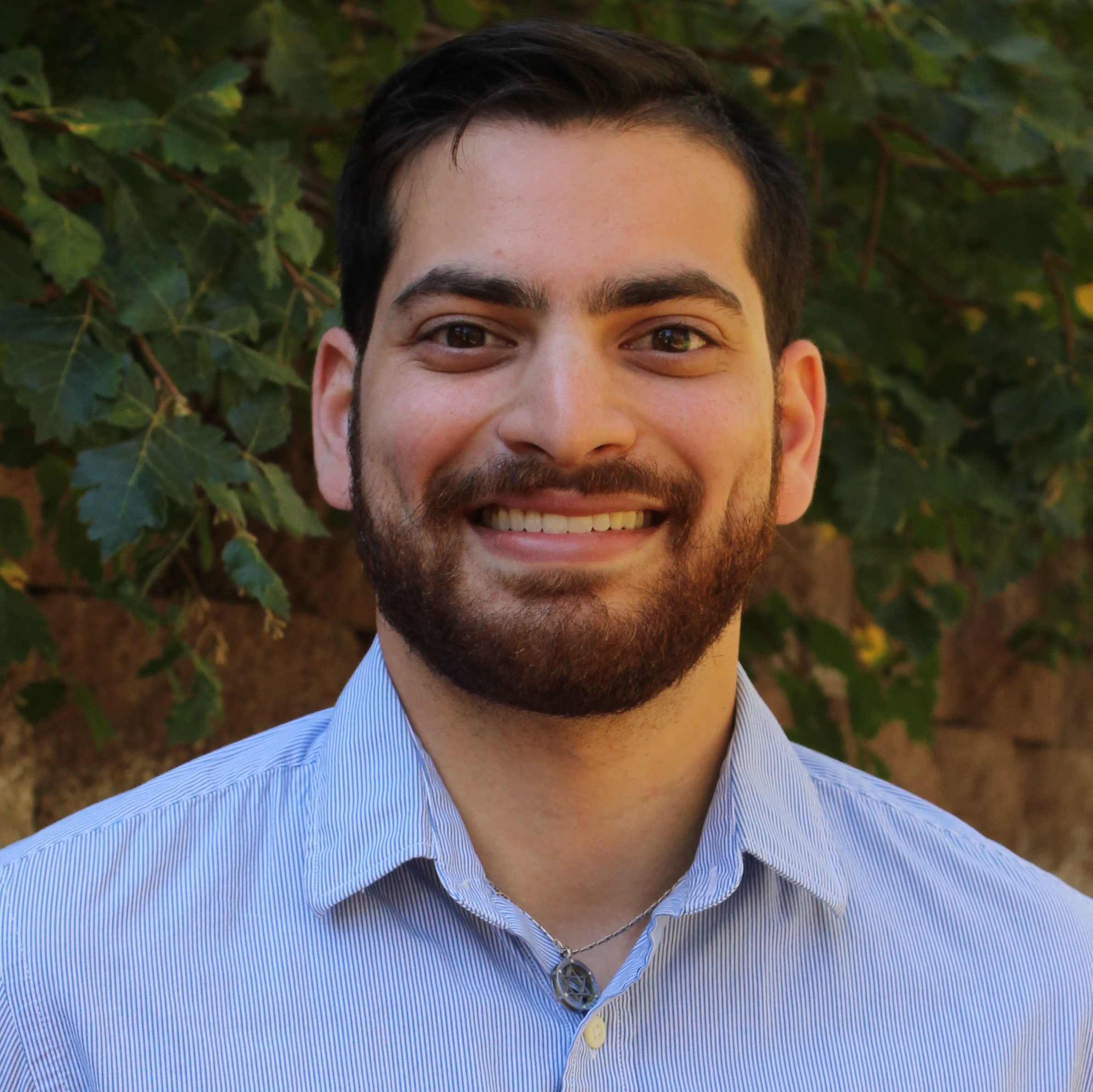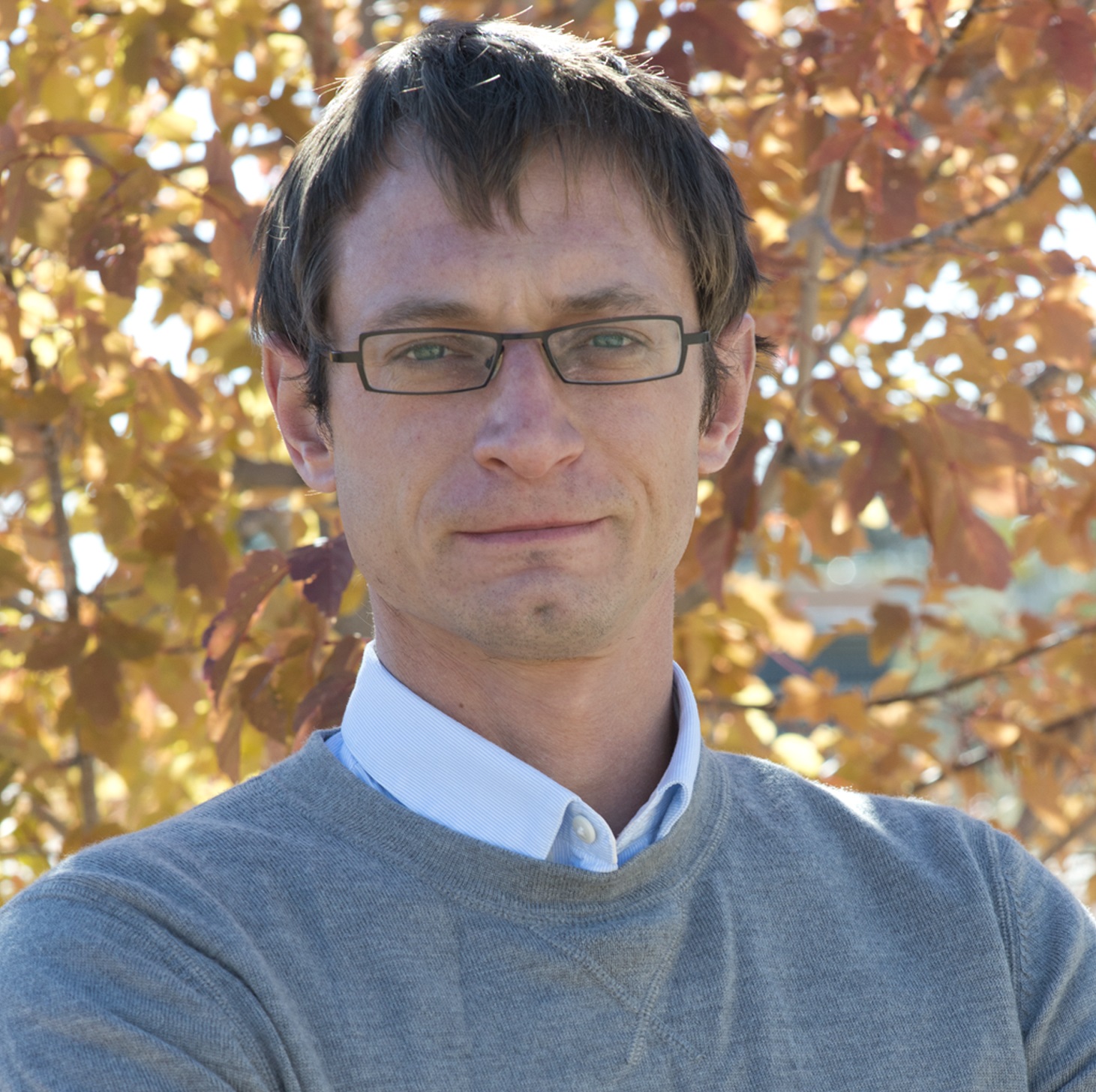STE Highlights, June 2023
Awards and Recognition
Accelerator Operations and Technology
Teaching Maxwell’s equations to 3D convolutional neural networks
Computer, Computational and Statistical Sciences
New framework developed for applying generative diffusion modeling
Materials Physics and Applications
Toward a standardized approach for evaluating PGM-free electrocatalysts
Awards and Recognition
Two Laboratory staff members attending the 2023 Lindau Nobel Laureate Meeting
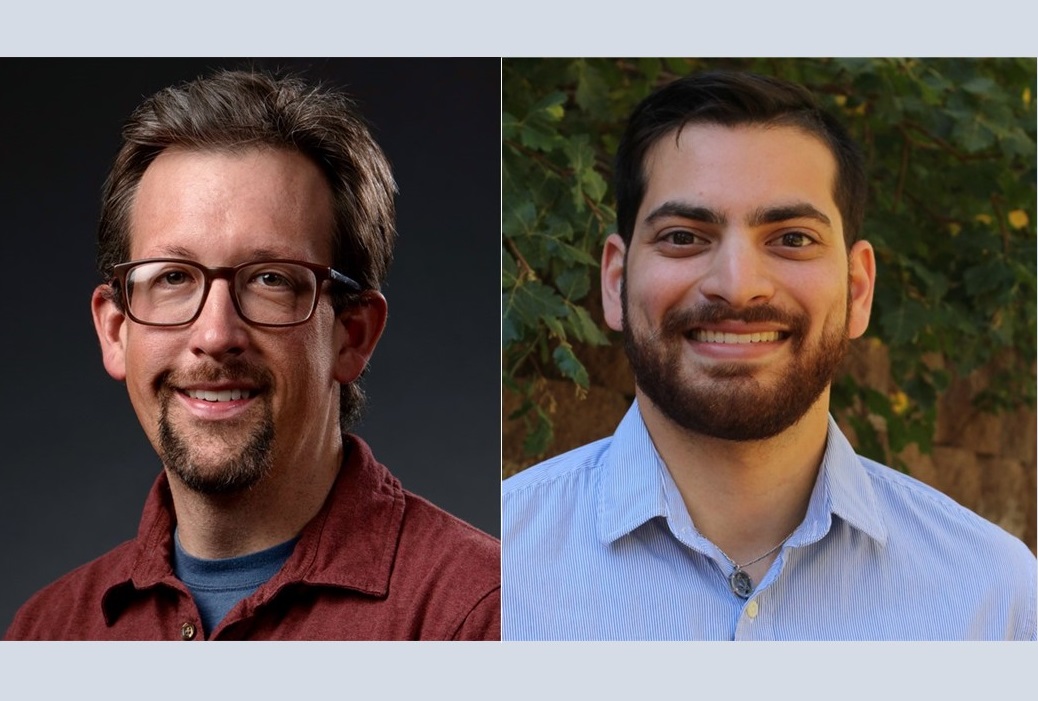
Andrew Bartlow and Zachary Sasiene
The Lindau Nobel Laureate Meetings represent a unique international scientific forum for the next generation of scientists. Two Bioscience division staff members, Andrew Bartlow (B-GEN) and Zachary Sasiene (B-TEK), will be participants in the 2023 Lindau Nobel Laureate Meeting, dedicated to physiology and medicine. The Laboratory representatives are among 600 next-generation scientists from around the world who will have the opportunity to exchange ideas and experiences and meet several dozen Nobel laureates also attending.
Bartlow was selected for the Lindau meeting in 2021, but because the in-person meeting was canceled due to COVID, Bartlow has been invited to attend this year’s event. The theme for the 70th meeting was interdisciplinary science; the scope of Bartlow’s work includes how biological communities can be used as signatures of environmental change as well as the biosurveillance of infectious diseases around the globe. Now a scientist at the Laboratory, Bartlow was a Director’s Postdoc Fellow from 2018 to 2021 after completing a doctoral degree in biology from the University of Utah. He earned a bachelor’s degree in biology from Wilkes University.
Sasiene, currently a Director’s Postdoc Fellow, has a background in analytical chemistry but has spent the last several years developing unique instrumentation for biomedical applications, particularly as part of the Bioscience division’s Mass Spectrometry Center for Integrated Omics. Sasiene received his doctoral degree in chemistry from West Virginia University and a bachelor’s degree in chemistry from the University of North Texas.
Andersson named American Nuclear Society 2023 Mishima Award winner
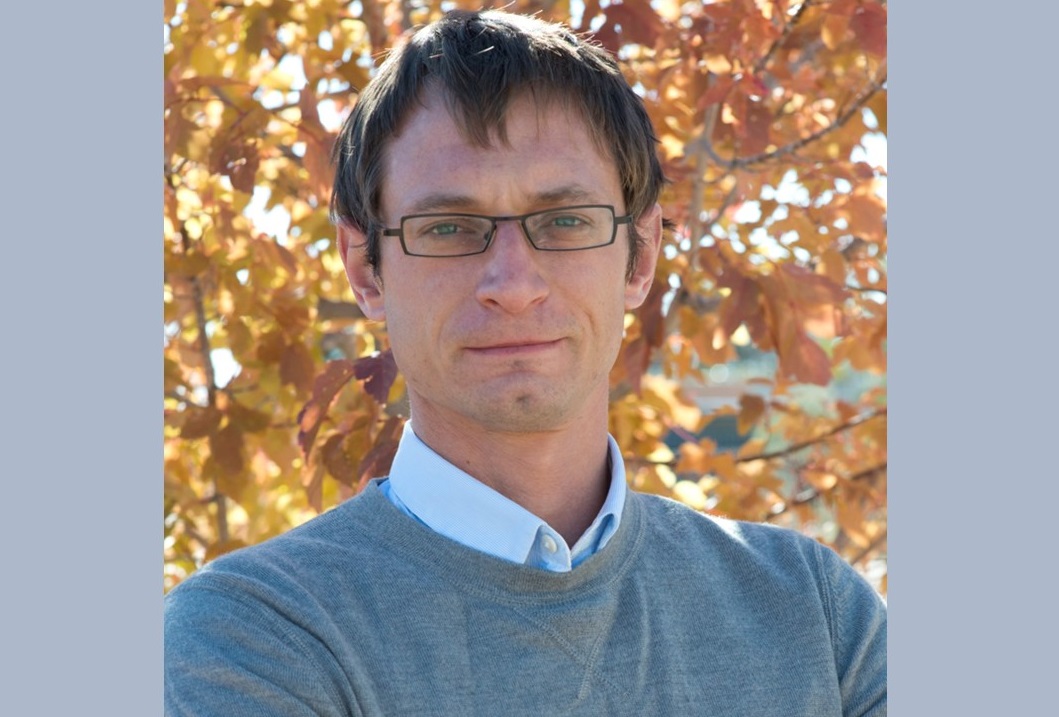
David Andersson
David Andersson, staff scientist in MST-8’s Modeling of Radiation Effects team, is the recipient of the 2023 American Nuclear Society’s Mishima Award, given for outstanding contributions in research and development work on nuclear fuels and materials. Andersson was specifically recognized “for advancing our understanding of nuclear fuel performance through fundamental studies of defect properties and their integration in performance models.”
Andersson is an expert in atomistic modeling of nuclear fuels — both traditional UO2 light water reactor fuel and advanced accident-tolerant fuel concepts. He has been involved in numerous international and national multiscale simulation efforts to develop models for use in nuclear fuel performance simulations. In particular, his work has used atomistic simulations of fission gas behavior and thermal conductivity to inform mesoscale simulations designed to capture the fuel’s evolving microstructure under irradiation.
Andersson is the deputy lead for the materials and fuel technical area of the DOE’s Nuclear Energy Advanced Modeling and Simulations Program, which aims to develop simulation tools for nuclear reactors. He previously held a similar position with the Consortium for Advanced Simulation of Light Water Reactors program, a DOE Energy Innovation Hub that aimed to develop modeling and simulation technology for a virtual version of existing operating nuclear reactors. As of last year, Andersson is also the Deputy National Technical Director for DOE’s Advanced Materials and Manufacturing Technologies program. He is the author of more than 110 published papers, which have been cited more than 5,000 times.
Andersson, who received his doctoral degree in materials science and engineering from Sweden’s Royal Institute of Technology, joined the Laboratory in 2007 as a Glenn T. Seaborg Postdoctoral Fellow.
Accelerator Operations and Technology
Teaching Maxwell’s equations to 3D convolutional neural networks
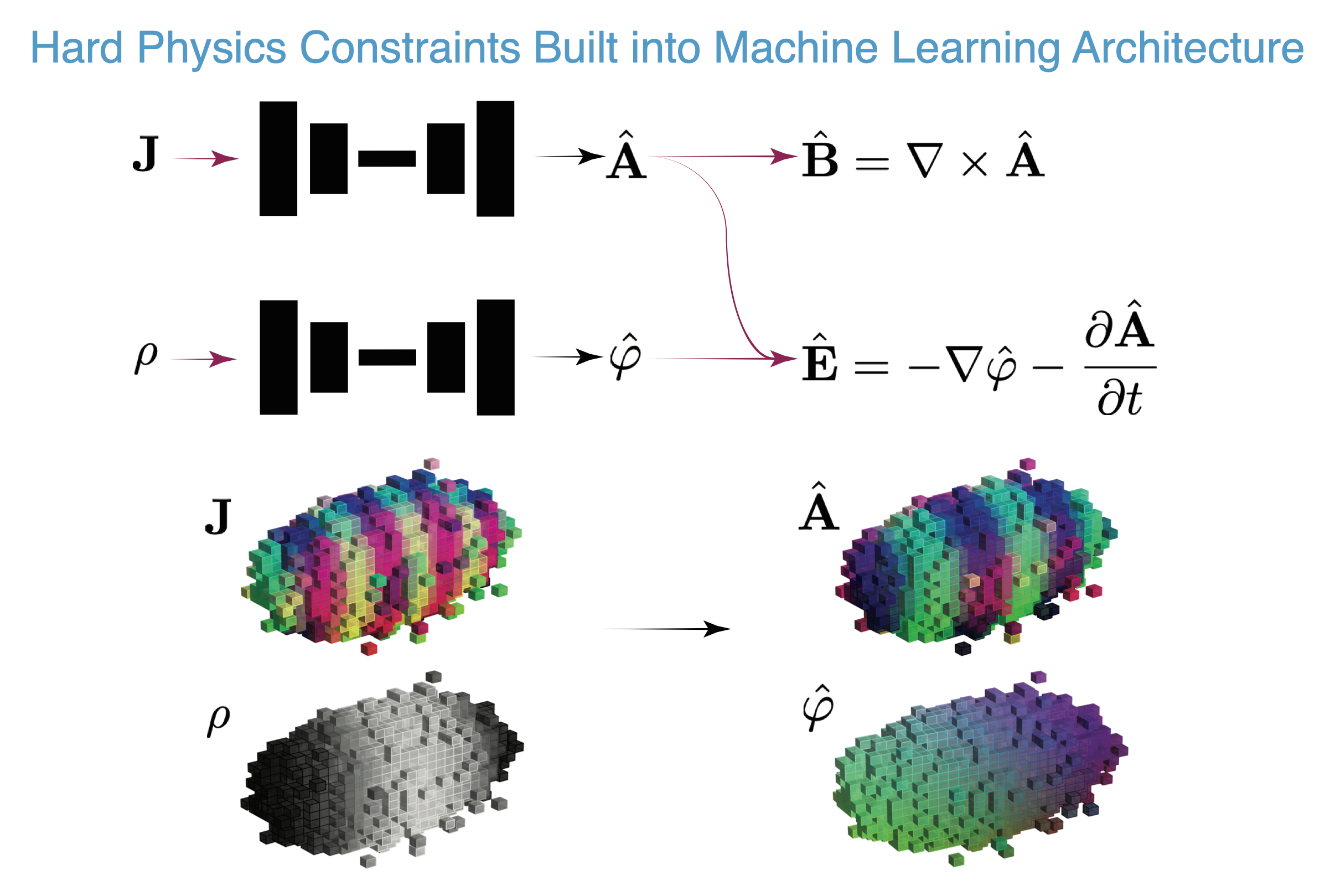
Schematic of the physics constrained 3D convolutional neural network-based neural operators for generating electric and magnetic fields while also satisfying the Lorenz gauge.
Examples of the 3D electric (red) and magnetic (blue) self-fields generated for relativistic electron bunches.
Studying the electrodynamics of large collections of interacting charged particles, as with an accelerator, is computationally expensive, especially when accounting for 3D collective effects in which the dynamics of individual charged particles and electromagnetic waves depend on the state of an entire ensemble. In a recently published paper, a team of scientists from Los Alamos National Laboratory’s Applied Electrodynamics (AOT-AE) and Materials Science in Radiation and Dynamics Extremes (MST-8) groups have developed a way to build hard physics constraints into physics-constrained 3D convolutional neural networks (PCNN) that are forced to respect Maxwell’s equations, the mathematical grounding for many electrical, optical and radio technologies. The PCNNs have the potential to optimize accelerator beam simulations, helping understand and improve performance.
One example of a collective effect important for particle accelerators is space charge (SC). Space charge plays a significant role in any accelerator that produces intense beams, for example the Advanced Photon Source; the Linac Coherent Light Source and the FACET-II user facility at the SLAC National Accelerator Laboratory; and Los Alamos’ own Los Alamos Neutron Science Center and the Dual-Axis Radiographic Hydrodynamic Test facility. In such facilities, short (10-100 fs) electron bunches have as much as 2 nanocoulomb of charge. The SC fields generated by intense charged particle beams act back on the beams themselves, significantly distorting the charge density and energy distribution. For a single 2 nanocoulomb electron bunch containing N1010 electrons, calculating exact individual particle-to-particle SC interactions is a computationally expensive O(N2) process.
Although various machine learning methods have been developed to try and speed up physics models, a main limitation has been a lack of enforcement of hard physics constraints. Physics-informed neural networks (PINNs) are very popular these days, but they only have soft constraints and therefore create physically inconsistent results that can violate energy conservation or Liouville’s theorem on the conservation of phase space volume. Furthermore, PINNs suffer from a tradeoff between prediction error and constraint violation.
The 3D PCNN neural operators the Laboratory team developed map 3D current and charge density J(x,y,z,t) and ρ(x,y,z,t) of a charged particle distribution to the associated vector and scalar potentials A(x,y,z,t) and φ(x,y,z,t) from which the electric and magnetic fields are generated according to B = ∇ x A and E = –∇φ – ∂A/ ∂t. By construction these neural operators respect hard physics constraints such as ∇.B = 0 and ∇ x E = – ∂B/∂t; there is no tradeoff between accuracy and constraint violation. Furthermore, because they utilize 3D convolutions in terms of number of weights, the networks are relatively small and run on individual high-performance servers with four to eight graphics processing units (GPUs) and even desktop workstations with two GPUs. Once trained, these PCNNs directly map incredibly large 256 x 256 x 256-pixel volumes of (J, ρ) fields to (E, B) fields within hundreds of μs, orders of magnitude faster than traditional O(N2) simulations.
The Los Alamos team is working to incorporate these PCNNs within particle tracking codes in order to greatly speed up the simulations of intense charged particle beams perturbed by strong collective effects. This work leverages the Lab’s machine learning and electrodynamics capabilities.
Funding and mission
This work was supported by the U.S. Department of Energy, Office of Science, Office of High Energy Physics and the Laboratory Directed Research and Development program at Los Alamos. The work supports the Global Security mission area and the Nuclear and Particle Futures capability pillar.
Reference
“Physics-constrained 3D convolutional neural networks for electrodynamics,” APL Machine Learning, 1, 026109 (2023); DOI: 10.1063/5.0132433. Authors: Alexander Scheinker and Reeju Pokharel (Los Alamos National Laboratory).
Technical contact: Alexander Scheinker (AOT-AE)
Bioscience
Recent paper selected as ‘New and Notable in Global Health’
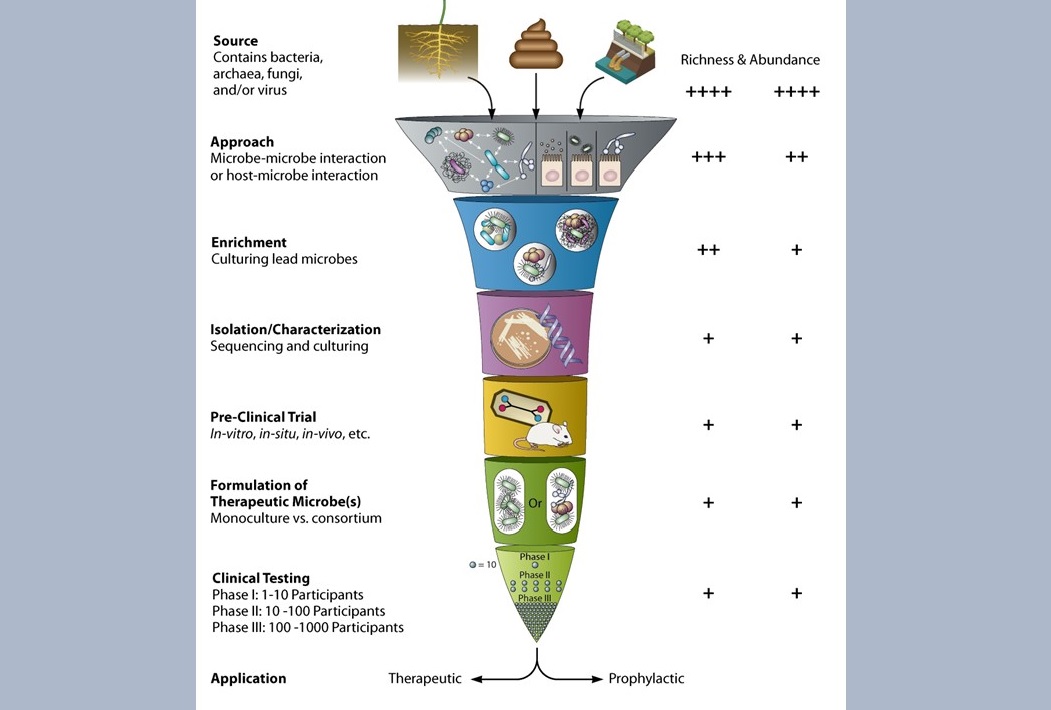
The work progression for the next generation of therapies, an effort to harness the power of the microbiome.
A mini-review authored by Los Alamos National Laboratory’s Anand Kumar and colleagues was recently selected as a “New and Notable Article” by the American Society for Microbiology (ASM). This selection was made from a collection of popular papers published in all 17 ASM journals over the last year. ASM Journals publish 26% of all microbiology articles and contribute 44% of all microbiology citations, making this recognition significant. Out of the hundreds of articles published in each journal annually, only 13 were selected as “new and notable.”
The mini-review titled “The Age of Next-Generation Therapeutic-Microbe Discovery: Exploiting Microbe-Microbe and Host-Microbe Interactions for Disease Prevention” was published in Infection and Immunity (I&I) journal in May 2022 and authored by Nathan Cruz, George A. Abernathy, Armand E. K. Dichosa, and Anand Kumar from the Bioscience division. In the review, Kumar and his team explain how poorly understood host- and microbe-microbe interactions can impact humans’ functions and overall well-being. They also note the lack of a universal technique to screen for potentially therapeutic microbes. In the mini-review, Kumar’s team discusses both historical (probiotics) and current (fecal microbiota or defined consortia) perspectives on therapeutic microbes and details their efforts to discover therapeutic microbes through novel microbiome screening platforms. Kumar has been recognized as a Future Leader by the I&I journal and has been inducted onto the journal's editorial board, where he will help to shape the future of research in this important area.
Mission and funding
The work has been supported by the Laboratory Directed Research and Development program at Los Alamos. The work supports the Global Security mission area and the Complex Natural and Engineered Systems capability pillar.
Reference
“The Age of Next-Generation Therapeutic-Microbe Discovery: Exploiting Microbe-Microbe and Host-Microbe Interactions for Disease Prevention,” Infection and Immunity, 90, 5 (2022); DOI: 10.1128/iai.00589-21. Authors: Nathan Cruz, George A. Abernathy, Armand E. K. Dichosa and Anand Kumar (Los Alamos National Laboratory)
Technical contact: Anand Kumar (B-TEK)
Computer, Computational and Statistical Sciences
New framework developed for applying generative diffusion modeling
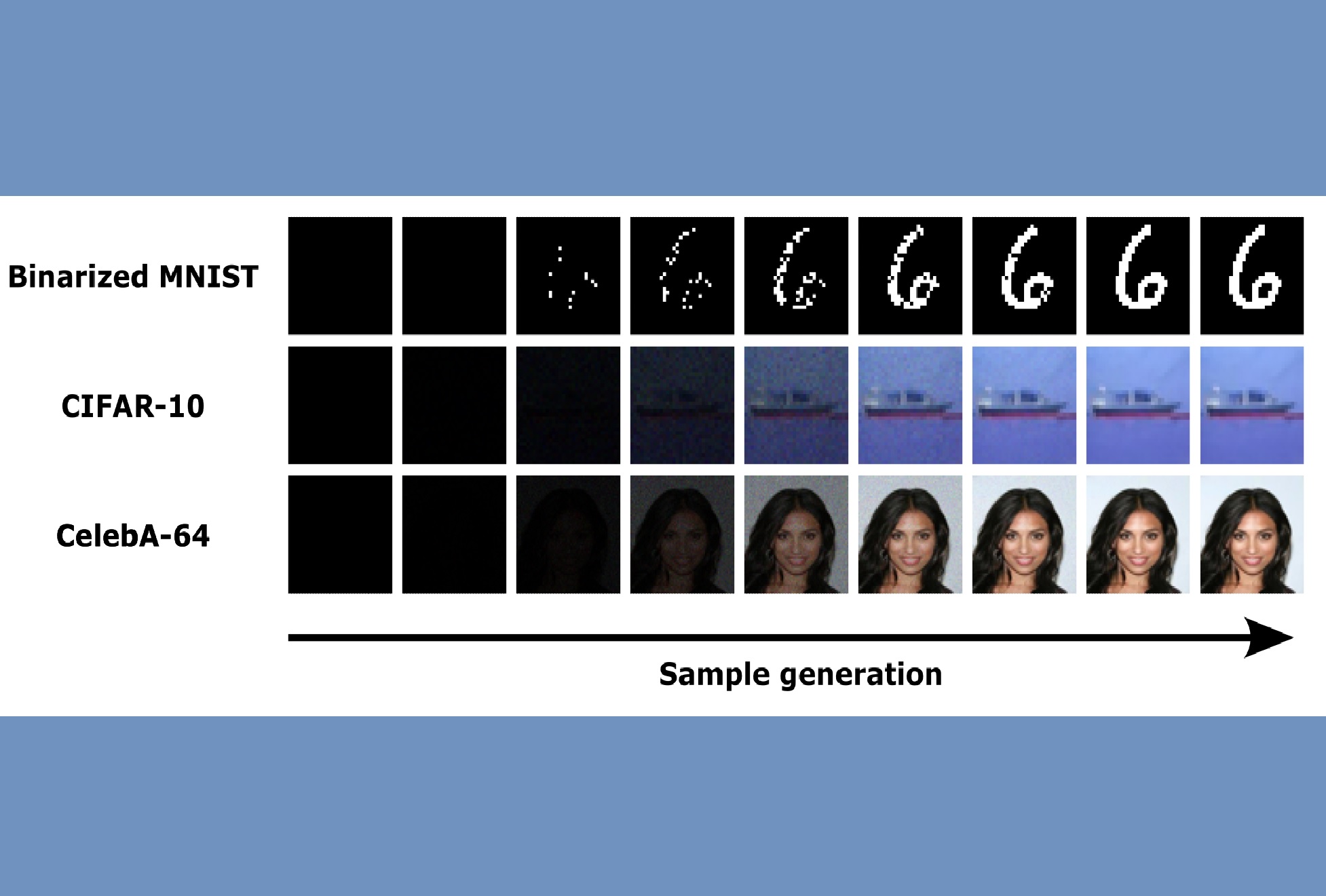
Blackout Diffusion utilizes a unique approach to generate never-before-seen samples from a black image. This process involves iteratively adding quantized intensity to every channel and pixel within the image, resulting in an array of visually striking outputs, including handwritten digits, objects and human faces.
A new theoretical foundation for generative diffusion models (GDMs) in discrete-state spaces has the potential to enable several scientific applications, such as graph, text, or mesoscopic computational fluid models. The development, described in a recent study presented at the 40th International Conference on Machine Learning, is the first of its kind.
Diffusion models are a type of generative models, that is, a model that learns both the features of a dataset and how to synthesize samples with similar features. Existing diffusion models, such as the DALL-E-2 and Midjourney, are able to generate artificial images that appear completely natural to human eyes. However, most diffusion models live in strictly continuous spaces, providing limits their potential for scientific applications. The Los Alamos team’s general theoretical framework for performing diffusion modeling in discrete-state spaces opens up opportunities for many scientific applications. They also demonstrated a prototype of this approach dubbed “Blackout Diffusion.”
Blackout Diffusion is motivated by radioactive beta decay, and as such is one of the first GDMs motivated by a physical process. The team tested Blackout Diffusion on a wide set of standardized datasets, including the binarized MNIST database (hand-written digits due to NIST), the CIFAR-10 dataset (images of objects in 10 different classes), and the Celeb-A (Celeb Faces Attributes Dataset, more than 200,000 human face images). The Blackout Diffusion framework was able to learn to produce all of its samples from an empty image, compared to existing approaches which require input noise. The team’s analysis showed that the quality of samples generated by Blackout Diffusion is comparable to the state-of-the-art diffusion models, but requires fewer compute resources that are usually used for training.
Furthermore, the Team used the Blackout Diffusion to clarify several widely conceived misconceptions, providing critical understanding of GDMs and designed principles for future scientific applications. This demonstrates the first datapoint to support effective discrete-state diffusion modeling, and points the way towards future scientific applications in many discrete-space modeling areas, such as molecular structure, multi-phase fluid flow, and single-cell biology experiments.
Reference
“Blackout Diffusion: Generative Diffusion Models in Discrete-State Spaces,” 40th International Conference on Machine Learning, PMLR 20 (2023); DOI: 10.48550/arXiv.2305.11089. Authors: Javier E. Santos, Zachary R. Fox, Nicholas Lubbers, Yen Ting Lin (Los Alamos National Laboratory).
Funding and mission
The work is supported by the Laboratory Directed Research and Development program at Los Alamos. The work supports the Global Security mission area and the Information, Science and Technology capability pillar.
Technical Contact: Yen Ting Lin (CCS-3)
Materials Physics and Applications
Toward a standardized approach for evaluating PGM-free electrocatalysts
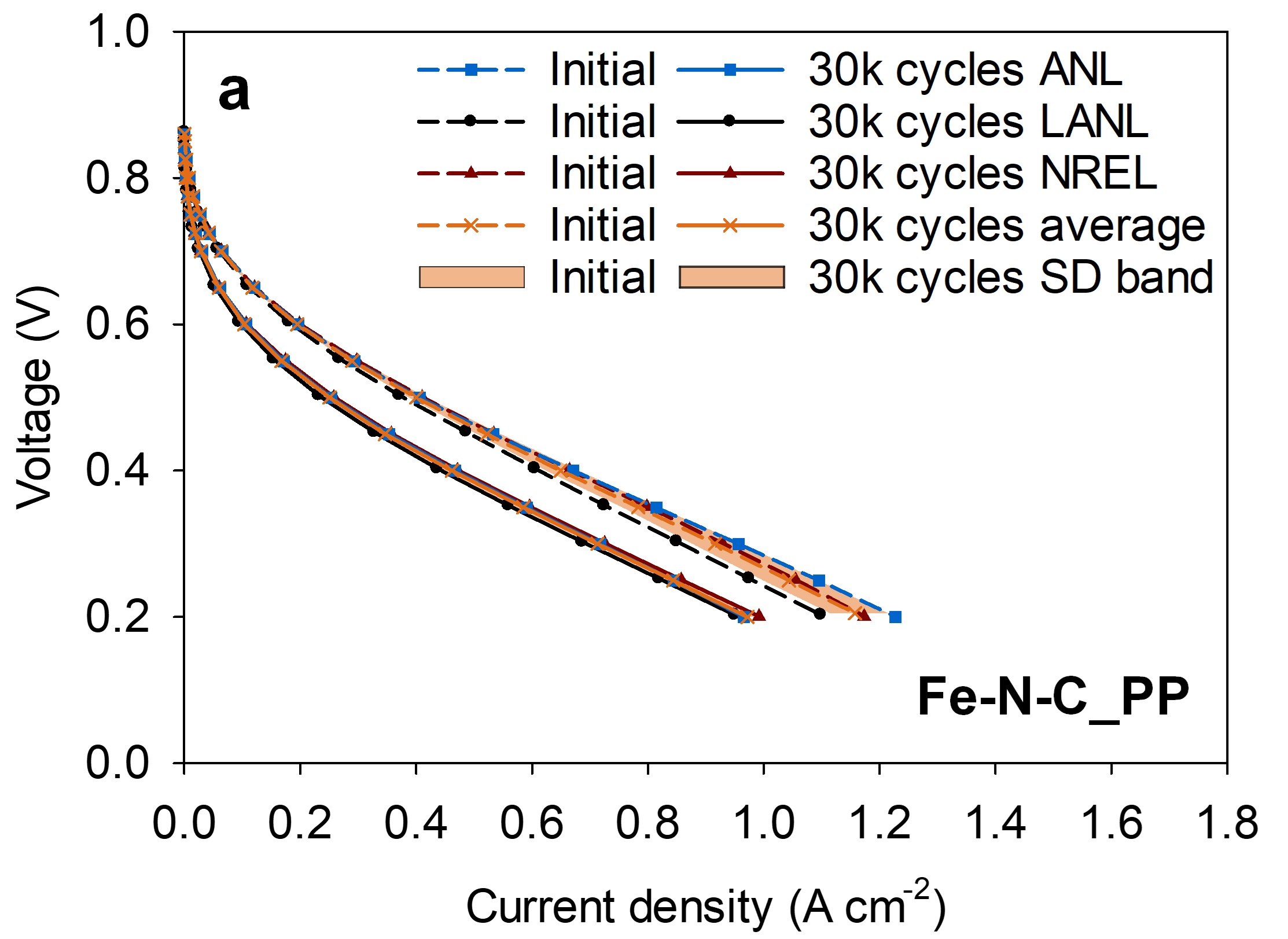
Protocol validation with Fe-N-C catalyst Pajarito Powder (commercial). Experiments involved recording fuel cell polarization curves, i.e., plots of voltage as a function of current density (a common way of representing fuel cell performance) at three national laboratories. Plots were taken at the beginning of testing and after 30,000 voltage cycles, mimicking performance of an automotive fuel cell. The average polarization data and corresponding standard deviation values attest to excellent agreement between results from the three labs, confirming validity of proposed test protocol.
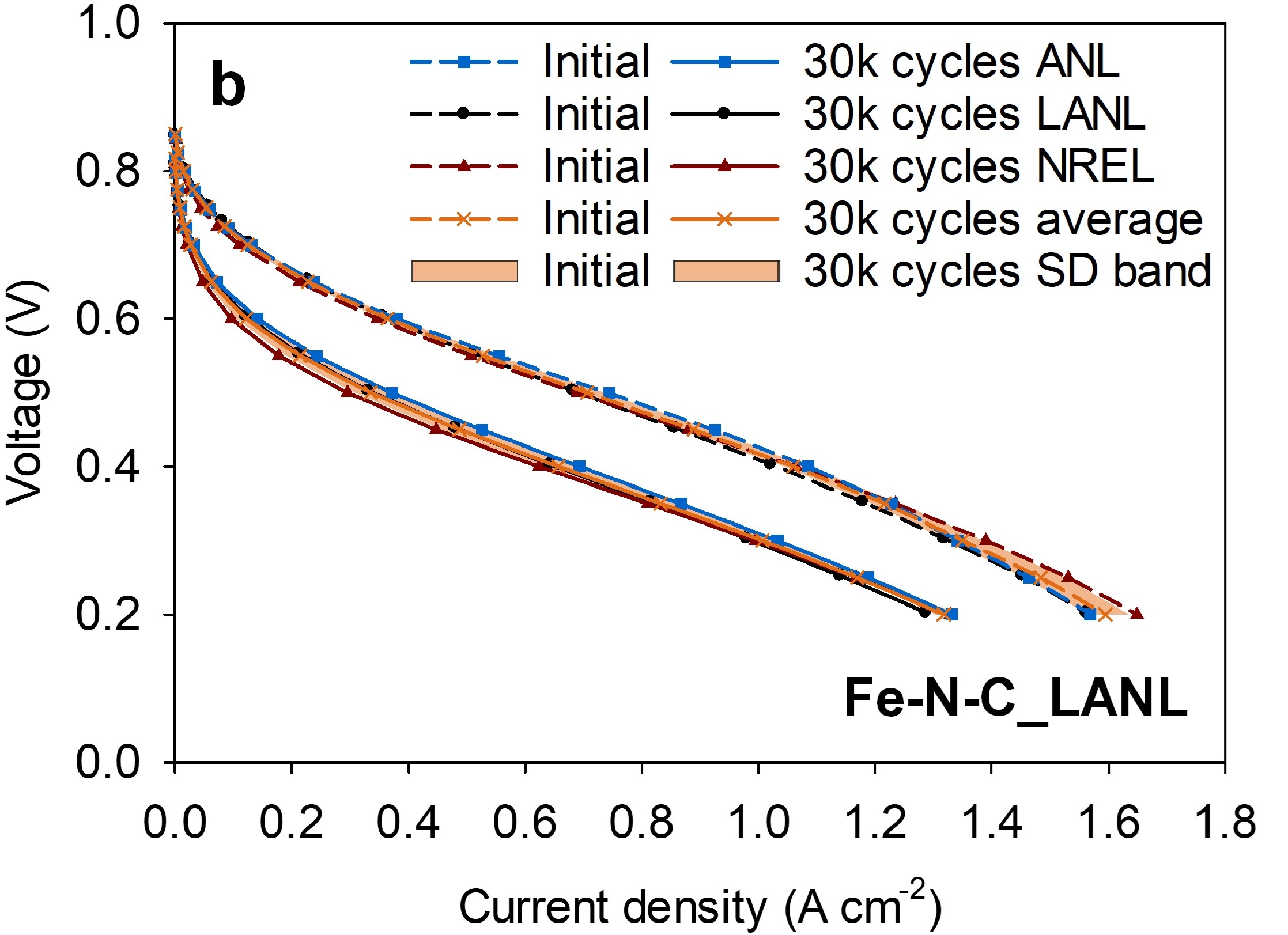
Protocol validation with Fe-N-C catalyst Los Alamos National Laboratory.
Despite years of study and substantial improvements in performance, platinum group metal-free (PGM)-free) electrocatalysts still suffer from insufficient stability and durability. Those deficiencies hinder the use of PGM-free electrocatalysts as an important alternative power source for a variety of practical applications, including automotive transportation.
In work published in Nature Catalysis, a team of Los Alamos researchers and external collaborators proposed and validated a set of test protocols, designed with special attention to typical catalyst degradation mechanisms of PGM-free catalysts. The results of their cross-laboratory validation study using two different catalysts attested to the strength and feasibility of the proposed approach. Based on this success, the PGM-free protocols have been approved by the Department of Energy and adopted by the DOE Electrocatalysis Consortium (ElectroCat) for the development of PGM-free catalysts.
Future improvements with PGM-free electrocatalysts have depended on the development of a broad and effective test protocols relevant to the operating conditions of the fuel cell cathode. Protocols must be completed within a reasonable time and ubiquitously adopted. In particular, the research team developed and implemented an adaptive learning design loop with uncertainty quantification to model and guide high-throughput synthesis of PGM-free fuel cell catalysts for oxygen reduction reaction (ORR). ORR is part of the means by which the catalyst generates electricity. Protocols were validated in round-robin testing performed in parallel at Los Alamos National Laboratory, Argonne National Laboratory, and the National Renewable Energy Laboratory.
The work leveraged Los Alamos’s fuel cell expertise and capabilities acquired in the internationally acclaimed LANL fuel cell program that dates to the 1970s. In particular, the work leveraged the program’s expertise in PGM-free catalyst development in the last 15 years.
The researchers now propose these protocols to the PGM-free catalyst research community at large as an effective platform for the assessing and reliably comparing the performance and durability of PGM-free electrocatalysts under development for fuel cell applications.
Funding and mission
Funding was provided by the DOE Office of Energy Efficiency and Renewable Energy, Hydrogen and Fuel Cell Technologies Office, under the ElectroCat Consortium, which Los Alamos co-leads with Argonne National Laboratory. The work supports the Lab’s Energy Security mission area and Materials for the Future capability pillar.
Reference
“Standardized protocols for evaluating platinum group metal-free oxygen reduction reaction electrocatalysts in polymer electrolyte fuel cells,” Nature Catalysis 5, 455 (2022). DOI: 10.1038/s41929-022-00778-3. Authors: Hanguang Zhang, Luigi Osmieri, Piotr Zelenay and Hoon Taek Chung (Los Alamos National Laboratory); Jae Hyung Park, Deborah J. Myers (Argonne National Laboratory); David A. Cullen (Oak Ridge National Laboratory); and Kenneth C. Neyerlin (National Renewable Energy Laboratory).
Technical contact: Piotr Zelenay (MPA-11)
Physics
MicroBooNE makes a challenging neutrino scattering measurement on argon for the first time
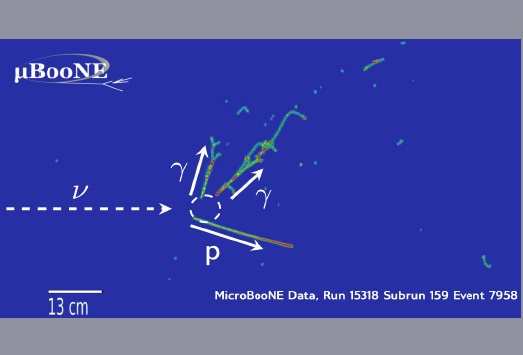
An event display of a neutral current neutral pion event found in the MicroBooNE data with a proton in the final state. The neutral pion is identifiable through the presence of two distinct electromagnetic showers, one for each photon from the neutral pion to double photon decay. The horizontal axis refers to the direction of the neutrino beam; the vertical axis represents the time-projection chamber drift time.
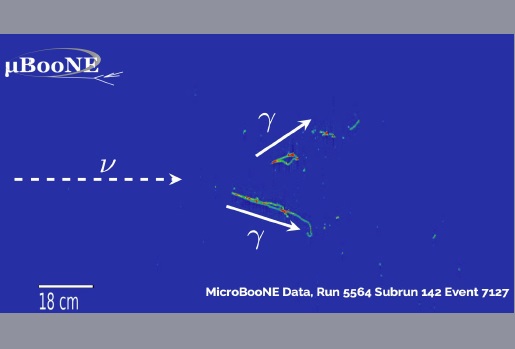
An event display of a neutral current neutral pion event found in the MicroBooNE data with no proton in the final state. The neutral pion is identifiable through the presence of two distinct electromagnetic showers, one for each photon from the neutral pion to double photon decay. The horizontal axis refers to the direction of the neutrino beam; the vertical axis represents the time-projection chamber drift time.
A team of researchers with the MicroBooNE neutrino experiment has provided critical new measurements in the efforts to understand neutrino interactions with matter. As reported in Physical Review D, recent results from the long-running liquid-argon accelerator experiment offer the first-ever measurement of neutral pion production in neutral current neutrino interactions on argon in the energy range of less than 1 giga electronvolt (GeV). These measurements offer valuable context for future measurements related to neutrino research.
Neutrinos come in three “flavors” (electron, muon, and tau) and rarely interact with matter. One of the bizarre properties of neutrinos is that they can morph into different flavors as they travel long distances. This phenomenon, referred to as “neutrino oscillations”, is widely used as an experimental probe in exploring questions not only about the nature and behavior of neutrinos, but also about the very existence of the universe. However, in order to interpret neutrino oscillation signals correctly, a detailed understanding of neutrino-nucleus interactions is essential. In particular, precise understanding of neutrino scattering on argon is paramount, as many of the current and future neutrino oscillation experiments use liquid argon as the nuclear target with which incoming neutrinos interact.
Using the novel liquid argon time projection chamber (LArTPC) technology to study neutrino interactions, the measurement obtained by the research team provides a key constraint on the rate of neutral current pion background in MicroBooNE’s recent search for a single-photon excess as a possible explanation for the long-standing MiniBooNE electromagnetic anomaly. This measurement is also important for electron oscillation searches that explore the question of existence of additional types of neutrinos (dubbed “sterile neutrinos”) by looking for electron-induced electromagnetic showers. Of particular importance in illuminating these oscillations and interactions — and the focus of the Physical Review D results — are neutral current scattering of neutrinos on an argon nucleus that produce a neutral pion, which subsequently decays into two photons. Without a better understanding of this process the produced photons can be incorrectly identified as electrons, leading to large backgrounds to neutrino oscillation searches.
Neutral current pions are one of the more dominant backgrounds to many next-generation searches for exciting new physics. They contribute as background to searches for rare neutrino scattering processes, such as the electron-positron production predicted by a number of beyond-the-standard-model theories. The ability to probe neutrino interactions to a possible “dark sector” containing sterile neutrinos or dark matter is highly constrained by an understanding of these interactions. The highest-statistics measurement yet of neutrino-induced neutral current single pion production on argon and the world’s first in the 1 GeV energy regime, the neutral current pion measurement represents a significant step forward in understanding, refining knowledge and paving the way for potential discoveries in the neutrino sector. The only other measurement of neutral current neutral pion production on argon is from a previous experiment at Fermilab called ArgoNEUT but at higher mean neutrino beam energy.
A follow-up analysis that expands this work into a suite of higher dimensional measurements is underway and being led by Los Alamos researchers. The current and future results hold high value to all ongoing and future experiments that use liquid argon as their nuclear target to explore fundamental questions about neutrinos. This includes the upcoming Short Baseline Neutrino (SBN) experimental program and the Deep Underground Neutrino Experiment (DUNE) at Fermilab.
Funding and mission
This work was supported by the U.S. Department of Energy, Office of Science, offices of High Energy Physics and Nuclear Physics; the U.S. National Science Foundation; the Swiss National Science Foundation; the Science and Technology Facilities Council (STFC), part of the United Kingdom Research and Innovation; the Royal Society (United Kingdom); and The European Union’s Horizon 2020 Marie Sklodowska-Curie Actions. The work supports the Global Security mission area and the Nuclear and Particle Futures capability pillar.
Reference
“Measurement of neutral current single π0 production on argon with the MicroBooNE detector,” Physical Review D 107, 012004 (2023); DOI: 10.1103/PhysRevD.107.012004. Authors: P. Abratenko, J. Mills, T. Wongjirad, K. Mason (Tufts University); J. Anthony, S. R. Dennis, P. Detje, A. F. Moor, A. Smith, J. Shi, N. Taniuchi, M. A. Uchida, K. Wresilo (University of Cambridge); L. Arellano, A. Bhanderi, J. J. Evans, O. G. Finnerud, O. Goodwin, P. Green, P. Guzowski, D. Marsden, L. Mora Lepin, A. Navrer-Agasson, K. Mistry, N. McConkey, M. Reggiani-Guzzo, S. Söldner-Rembold, (The University of Manchester); J. Asaadi, Z. Williams (University of Texas); A. Ashkenazi, E. Piasetzky (Tel Aviv University); S. Balasubramanian, B. Baller, V. Basque, S. Berkman, M. Bhattacharya, F. Cavanna, G. Cerati, M. Del Tutto, S. Gardiner, E. Gramellini, H. Greenlee, C. James, W. Ketchum, M. Kirby, T. Kobilarcik, T. Mohayai, C. D. Moore, O. Palamara, Z. Pavlovic, J. L. Raaf, A. Schukraft, R. Sharankova, E. L. Snider, P. Spentzouris, M. Stancari, J. St. John, T. Strauss, M. Toups, S. Wolbers, M. Wospakrik, L. E. Yates, W. Wu, T. Yang, G. P. Zeller, J. Zennamo (Fermi National Accelerator Laboratory); C. Barnes, R. S. Fitzpatrick, J. Mousseau, J. Spitz (University of Michigan); G. Barr, K. Duffy (University of Oxford); J. Barrow, J. M. Conrad, O. Hen, N. Kamp, A. Papadopoulou, N. Wright (Massachusetts Institute of Technology); L. Bathe-Peters, J. Y. Book, N. Foppiani, R. Guenette, S. Prince (Harvard University); O. Benevides Rodrigues, A. Bhat, K. Manivannan, M. Nunes, M. Soderberg (Syracuse University); M. Bishai, W. Gu, X. Ji, Y. Li, N. Nayak, V. Radeka, X. Qian, D. Torbunov, B. Viren, H. Wei, H. W. Yu, C. Zhang (Brookhaven National Laboratory); A. Blake, A. Devitt, J. Nowak, N. Patel, C. Thorpe (Lancaster University); T. Bolton, G. A. Horton-Smith, V. Meddage, R. K. Neely, A. Paudel, A. Rafique (Kansas State University); L. Camilleri, D. Cianci, G. Ge, Y.-J. Jwa, D. Kalra, G. Karagiorgi, M. Ross-Lonergan, W. Seligman, M. H. Shaevitz, K. Sutton (Columbia University); D. Caratelli, N. Kaneshige, M. B. Leibovitch, X. Luo, D. Totani, E. Yandel (University of California, Santa Barbara); I. Caro Terrazas, A. Mogan, M. Mooney (Colorado State University); Y. Chen, R. Diurba, A. Ereditato, I. Kreslo, T. Mettler; S. Mulleriababu, C. Rudolf von Rohr, J. Sinclair, M. Weber (Universität Bern); M. Convery, R. Itay, L. Rochester, K. Terao, Y.-T. Tsai, T. Usher (SLAC National Accelerator Laboratory); L. Cooper-Troendle, B. T. Fleming, D. Franco, L. Hagaman, J. H. Jo, K. Li, I. D. Ponce-Pinto, G. Scanavini, A. J. White (Yale University); J. I. Crespo-Anadón (Centre for Energy, Environmental and Technological Research); R. Dorrill, B. R. Littlejohn (Illinois Institute of Technology); S. Dytman, D. Naples, V. Paolone, L. C. J. Rice, M. Rosenberg (University of Pittsburgh); B. Eberly (University of Southern Maine); R. Fine, S. Gollapinni, R. Hicks, K. Lin, W. C. Louis, D. A. Newmark, N. Oza (Los Alamos National Laboratory); G. A. Fiorentini Aguirre, D. A. Martinez Caicedo, J. Rodriguez Rondon (South Dakota School of Mines and Technology); A. P. Furmanski, C. Hilgenberg (University of Minnesota); D. Garcia-Gamez (Universidad de Granada); L. Jiang, C. Mariani (Virginia Tech); R. A. Johnson (University of Cincinnati); I. Lepetic, A. Mastbaum (Rutgers University); J.-Y. Li, M. Nebot-Guinot, H. B. Parkinson, A. M. Szelc (University of Edinburgh); J. Marshall (University of Warwick); K. Miller, D. W. Schmitz (University of Chicago); V. Papavassiliou, S. F. Pate, L. Ren, S. Sword-Fehlberg (New Mexico State University); W. Tang, G. Yarbrough (University of Tennessee).
Technical contact: Sowjanya Gollapinni (P-2)
Theoretical
Laboratory researchers contribute to book on artificial intelligence
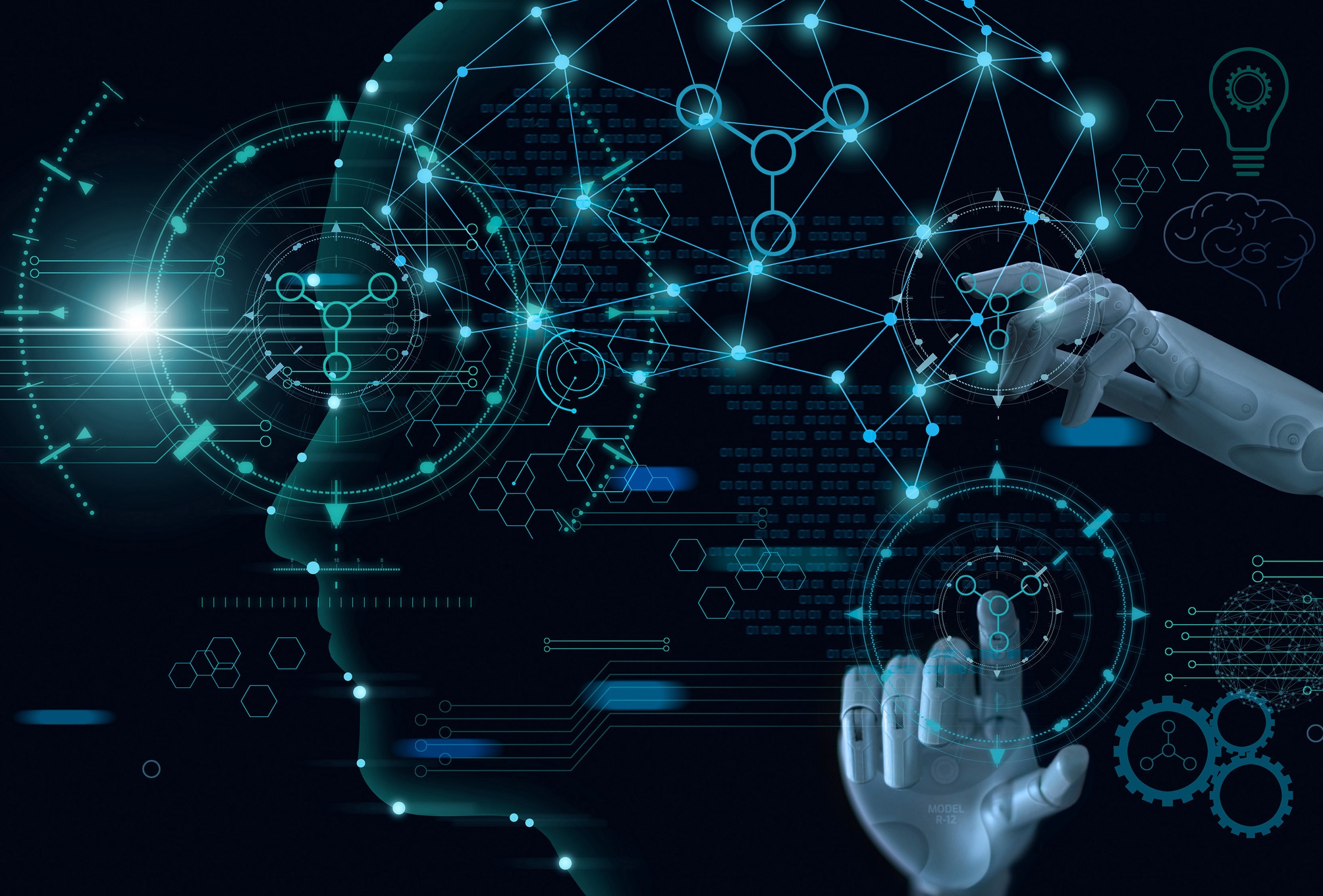
The new textbook features contributions from Laboratory researchers on the methods and applications of machine learning in science.
A new textbook, “Artificial Intelligence for Science: A Deep Learning Revolution” explores the use of machine learning, especially deep learning, in science. Geared toward researchers, academics, students and others, the book “introduces AI, Machine Learning, and deep neural network technologies leading to scientific discovery from […] datasets generated both by supercomputer simulation and by modern experimental facilities.”
Several Los Alamos National Laboratory researchers have made key contributions to the book. Rajan Gupta is the lead author of a chapter on “AI and Theoretical Particle Physics” — joined as a Laboratory author by colleague Tanmoy Bhattacharya and Boram Yoon, formerly with the Lab — on a chapter that discusses how theoretical particle physics makes use of machine learning. The authors explore the issue of guarantees of correctness in machine learning by use of algorithms that accept, reject or refine educated guesses to solve difficult problems. Recently it has been shown that deep learning can provide the good guesses to improve the efficiency of algorithms, based on maintenance of the physics-based symmetries of a given problem. The efforts represent a useful collaboration between machine learning and theoretical physics communities.
Bhattacharya led the authorship of a chapter on “Uncertainty Quantification in AI for Science,” with contributions from Cristina Garcia Cardona and Jamaludin Mohd-Yusof. Along with a survey of the field, the authors describe methods developed at the Laboratory to carry out rigorous uncertainty quantification in machine learning models for the Pilot 3 component of the Joint Design of Advanced Computing for Cancer, as well as the CANcer Distributed Learning Environment project. Through these activities, it was realized that in using machine learning, knowing the average uncertainties on a project was not sufficient; rather, the specific uncertainty on a given response was necessary. For instance, knowing that a classifier is correct 97% of the time is not as useful as separating the confident — and correct — answers from those with a larger uncertainty.
Reference
“Artificial Intelligence for Science: A Deep Learning Revolution,” World Scientific (2023). DOI: 10.1142/13123. Los Alamos contributors: Rajan Gupta, Tanmoy Bhattacharya, Cristina Garcia Cardona and Jamaludin Mohd-Yusof (Los Alamos National Laboratory).
Mission
This work supports the Global Security mission and the Information, Science and Technology capability pillar.
Technical contact: Tanmoy Bhattacharya (T-2)


